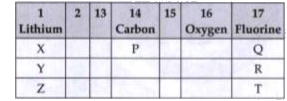A less reactive metal can displace a more reactive metal from the solution of its salt. (True / False)
The correct Answer is:F
Step by step video, text & image solution for A less reactive metal can displace a more reactive metal from the solution of its salt. (True / False) by Chemistry experts to help you in doubts & scoring excellent marks in Class 10 exams.
Updated on:21/07/2023Similar Questions
Knowledge Check
Which is most reactive metal
AFeBPtCNiDCoCertain metals have the capacity to displace some metals from their salt solutions. These reactions are known as metal displacement reactions. A metal placed higher in activity series can displace the metal occupying lower position from aqueous solution of its salt or a more reactive metal can displace less reactive metal from its salt solution.
Q. If a zinc rod is dipped in copper sulphate solution, following changes will be noticed. mark the correct observations.
(i) Zinc rod slowly loses its weight.
(ii) Copper settles at the bottom of the beaker.
(iii) Blue colour of copper sulphate disappears.A(i) and (ii) onlyB(i), (ii) and (iii) onlyC(i) and (iii) onlyD(iii) onlyCertain metals have the capacity to displace some metals from their salt solutions. These reactions are known as metal displacement reactions. A metal placed higher in activity series can displace the metal occupying lower position from aqueous solution of its salt or a more reactive metal can displace less reactive metal from its salt solution.
Q. Take aqueous solution of copper sulphate in one test tube and ferrous sulphate in another test tube. dip an iron nail in copper sulphate and copper wire in ferrous sulphate solution. mark the correct observation.ABlue colour in first test tube changes to light green and green in the second test tube changes to blueBThere is no reaction in both the test tubes.CBlue colour in first test tube changes to light green and no change in second test tubeDBlue colour remains as such and green colour in second test tube changes to blue
The most reactive non metal
View SolutionThe most reactive non-metal
View SolutionDisplacement reaction is a reaction in which a less reactive metal is displaced from its salt by a more reactive metal. From the reactivity series, we can find that metals higher up in the series are more reactive than metals present lower in the series.
Write Yes or No For each of the following situations to show whether a displacement reaction can take place or not.
(a). Reaction between zinc sulphate and iron.___________
(b). Reaction between iron oxide and aluminium._________
(c). Reaction between silver nitrate and copper. __________
(d). Reaction between aluminium phosphate and nickel___________
View Solution
Which is the most reactive metal ?
View SolutionAssertion: Mg2++ZnSO4→MgSO4+Zn2+
Reason: More active metal can displace less active metal from its salt solution.
View Solution
